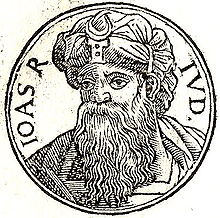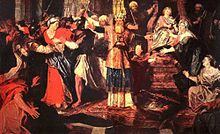Jehoash of Judah
| Jehoash | |
|---|---|
 Jehoash from Guillaume Rouillé's Promptuarii Iconum Insigniorum, 1553 | |
| King of Judah | |
| Reign | c. 836 – 796 BC |
| Predecessor | Athaliah |
| Successor | Amaziah |
| Born | c. 843 BC Jerusalem, Kingdom of Judah |
| Died | c. 797 BC (aged 45 or 46) Millo, Jerusalem |
| Burial | |
| Consort | Jehoaddan of Jerusalem |
| Issue | Amaziah, King of Judah |
| House | House of David |
| Father | Ahaziah, King of Judah |
| Mother | Zibiah of Beersheba |
Template:Kings of Judah Jehoash (Hebrew: יְהֹואָשׁ, Yəhôʾāš, “Jehovah-given”; Template:Lang-el; Template:Lang-la), also known as Joash (in King James Version), Joas (in Douay–Rheims) or Joás (Hebrew: יֹואָשׁ, Yôʾāš),[1] was a king of Judah, and the sole surviving son of Ahaziah after the massacre of the royal family ordered by his grandmother, Athaliah. He was also the first Judahite king to be descended from both the House of David and the House of Omri, through his paternal grandmother and predecessor, Athaliah. His mother was Zibiah of Beersheba. Jehoash was 7 years old when his reign began, and he reigned for 40 years.[2] (2 Kings 12:1,2 Chronicles 24:1) He was succeeded by his son, Amaziah of Judah.
William F. Albright has dated his reign to 837 – 800 BC, while E. R. Thiele offers the dates 835 – 796 BC.[3]
The Gospel of Matthew does not list Jehoash of Judah in the genealogy of Jesus, being one of four kings of Judah so omitted, the other three being Ahaziah, Amaziah, and Jehoiakim.
Early life

According to the Hebrew Bible, following the death of his father, Ahaziah, Jehoash was spared from the rampages of Ahaziah's mother, Athaliah, by Jehoash's paternal aunt, Jehosheba, who was married to the high priest, Jehoiada.[2][4][5] After hiding him in the Temple for seven years, Jehoiada had Jehoash crowned and anointed king in a coup against Athaliah, who had usurped the throne of David. Athaliah was killed during the coup.[6][7][8][9][10]
After Jehoash was crowned, the covenant was renewed between God, the king, and the nation, and the Tyrian cult of Baal, which had started under Jehoram, and strengthened under Athaliah, was suppressed. Mattan, the priest of Baal, was killed, the altars of Baal were destroyed, and for the first time in Judah's history the Jerusalem Temple, and its priesthood achieved national importance.[11][12][13]
Later life and death
After Jehoiada died Jehoash was in conflict with the Jerusalem priesthood. According to 2 Chronicles 24, Zechariah, Jehoiada's son and successor, was put to death, by stoning.[14] The author of the Books of Chronicles attributes Jehoash's deeds to the oppression suffered at the hands of Aramean invaders as God's judgement.[15]
When the Syrian king Hazael marched against Jerusalem, Jehoash is said to have tried to bribe him with the gold of the royal and sacred treasuries to turn back;[16][17] but[18] the Syrian army persisted and destroyed all the princes of Judah and the soldiers "executed judgment against Joash," and they left him severely wounded. However this account is unlikely to be true.[19]
Jehoash was assassinated by his own servants at Millo, and his assassination is portrayed as an act of revenge for the blood of Zechariah, the son of Jehoiada.[20][21] Joash was buried together with his fathers in the City of David,[22] although he was "not (buried) in the sepulchres of the kings."[23]
In rabbinic literature
The extermination of the male descendants of David was considered a divine retribution for David's responsibility for the extermination of the priests by Saul, who had commanded his servant Doeg to perform this task (comp. 1 Sam. 22:17–23). Joash escaped death because in the latter case one priest, Abiathar, survived (Sanh. 95b). The hiding-place of Joash was, according to R. Eleazar, one of the chambers behind the Holy of Holies; according to R. Samuel b. Naḥman, one of the upper chambers of the Temple (Cant. R. i. 66).[24]
Although a king who is the son of a king need not be anointed, exception was made in the case of Joash, as well as of Solomon[25] and Jeoahaz,[26] the succession of each of whom was contested (Lev. R. x. 8). Particular mention is made of the crown placed on Joash's head (2 Kings 11:12), because it fitted exactly, showing that he was qualified for kingship (Ab. Zarah 44a).
He was assassinated by two of his servants, one of whom was a son of an Ammonite woman and the other the offspring of a Moabite (2 Chron. 24:26); for God said: "Let the descendants of the two ungrateful families chastise the ungrateful Joash" (Yalk., Ex. 262). Ironically, Moab and Ammon were the two offspring of Lot's incest with his two daughters as described in Gen. 19:30–38.
Jehoash Tablet
In 2001, an unprovenanced inscription was published, known as the Jehoash Inscription or Temple Inscription, which appears to be a record of repairs made to Solomon's Temple during Jehoash's reign. The tablet consists of 15 lines of Hebrew text inscribed on a piece of tabular black stone.[27] Following extensive scientific tests, the Israeli archaeological authorities declared it to be a forgery attempted but failed to prosecute the perpetrator; today a number of experts maintain that it is not a forgery.[28]
Chronological notes
The calendars for reckoning the years of kings in Judah and Israel were offset by six months, that of Judah starting in Tishri (in the fall) and that of Israel in Nisan (in the spring). Cross-synchronizations between the two kingdoms therefore often allow narrowing of the beginning and/or ending dates of a king to within a six-month range. For Jehoash, the Scriptural data allow the narrowing of his accession to some time between Nisan 1 of 835 BC and the day before Tishri 1 of the same BC year. For calculation purposes, this should be taken as the Judean year beginning in Tishri of 836/835 BC, or more simply 836 BC. His death occurred at some time between Nisan 1 of 796 BC and the day before Tishri 1 of that BC year, i.e. in 797/796, or more simply, 797 BC. During his reign, the Judean court recorders were still using the non-accession system of measuring years that was adopted in the days of Jehoshaphat from the practice of the northern kingdom, whereby the king's first partial year in office was counted as his first year of reign.
Ancestry
| Family of Jehoash of Judah | |||||||||||||||||||||||||||||||||||||||||||||||||||||||||||||||||||||||||||||||||||||||||||||||||||||||||||||||||||||||||||||||||||||||||||||||||||||||||||||||||||||||||||||||||||||||||||||||||||||||||||||||||||||||||||||||||||||||||||||||||||||||||||||||||||||||||||||||||||||||||||||||||||||||||||||||||||||||||||||||||||||||||||||||||||||||||||||||||||||||||||||||||||||||||||||||||||||||||||||||||||||||||||||||||||||||||||||||||||||||||||||||||||||||||||||||||||
|---|---|---|---|---|---|---|---|---|---|---|---|---|---|---|---|---|---|---|---|---|---|---|---|---|---|---|---|---|---|---|---|---|---|---|---|---|---|---|---|---|---|---|---|---|---|---|---|---|---|---|---|---|---|---|---|---|---|---|---|---|---|---|---|---|---|---|---|---|---|---|---|---|---|---|---|---|---|---|---|---|---|---|---|---|---|---|---|---|---|---|---|---|---|---|---|---|---|---|---|---|---|---|---|---|---|---|---|---|---|---|---|---|---|---|---|---|---|---|---|---|---|---|---|---|---|---|---|---|---|---|---|---|---|---|---|---|---|---|---|---|---|---|---|---|---|---|---|---|---|---|---|---|---|---|---|---|---|---|---|---|---|---|---|---|---|---|---|---|---|---|---|---|---|---|---|---|---|---|---|---|---|---|---|---|---|---|---|---|---|---|---|---|---|---|---|---|---|---|---|---|---|---|---|---|---|---|---|---|---|---|---|---|---|---|---|---|---|---|---|---|---|---|---|---|---|---|---|---|---|---|---|---|---|---|---|---|---|---|---|---|---|---|---|---|---|---|---|---|---|---|---|---|---|---|---|---|---|---|---|---|---|---|---|---|---|---|---|---|---|---|---|---|---|---|---|---|---|---|---|---|---|---|---|---|---|---|---|---|---|---|---|---|---|---|---|---|---|---|---|---|---|---|---|---|---|---|---|---|---|---|---|---|---|---|---|---|---|---|---|---|---|---|---|---|---|---|---|---|---|---|---|---|---|---|---|---|---|---|---|---|---|---|---|---|---|---|---|---|---|---|---|---|---|---|---|---|---|---|---|---|---|---|---|---|---|---|---|---|---|---|---|---|---|---|---|---|---|---|---|---|---|---|---|---|---|---|---|---|---|---|---|---|---|---|---|---|---|---|---|---|---|---|---|---|---|---|---|---|---|---|---|---|---|---|---|---|---|---|---|---|---|---|---|---|---|---|---|---|---|---|---|---|---|---|---|---|---|---|---|---|---|---|---|---|---|---|---|---|---|---|---|---|---|---|---|---|---|---|---|---|---|---|---|---|---|---|---|
| |||||||||||||||||||||||||||||||||||||||||||||||||||||||||||||||||||||||||||||||||||||||||||||||||||||||||||||||||||||||||||||||||||||||||||||||||||||||||||||||||||||||||||||||||||||||||||||||||||||||||||||||||||||||||||||||||||||||||||||||||||||||||||||||||||||||||||||||||||||||||||||||||||||||||||||||||||||||||||||||||||||||||||||||||||||||||||||||||||||||||||||||||||||||||||||||||||||||||||||||||||||||||||||||||||||||||||||||||||||||||||||||||||||||||||||||||||
References
- ^ 1 Chronicles 3:11
- ^ a b "Joash", Jewish Encyclopedia
- ^ Edwin R. Thiele, The Mysterious Numbers of the Hebrew Kings (3rd ed.; Grand Rapids, MI: Zondervan/Kregel, 1983) 217.
- ^ 2 Kings 11:2
- ^ 2 Chronicles 22:11
- ^ 2 Kings 11:4
- ^ 2 Chronicles 23:3
- ^ 2 Kings 11:12
- ^ 2 Chronicles 23:11
- ^ Encyclopaedia Judaica | second edition | vol 11 | pg 343
- ^ 2 Kings 11:17–19
- ^ 2 Chronicles 23:16–20
- ^ Encyclopaedia Judaica | second edition | vol 11 | pg 343
- ^ 2 Chronicles 24:20–21
- ^ 2 Chronicles 24:22–23
- ^ 2 Kings 12:18–19
- ^ 2 Kings 12:17–18
- ^ 2 Chronicles 24:23–25
- ^ Encyclopaedia Judaica | second edition | vol 11| pg 343
- ^ 2 Kings 12:1,21
- ^ 2 Chronicles 24:1,25
- ^ 2 Kings 12:21–22
- ^ 2 Chronicles 24:25
- ^ Jewish Encyclopedia
- ^ 1 Kings 1:39
- ^ 2 Kings 23:30
- ^ "Jehoash Tablet - Cultural Heritage Resource". stanford.edu.
- ^ Giuseppe Regalzi, The So-Called ‘Jehoash Inscription’: Transcription and Bibliography. Retrieved 23 September 2011.
![]() This article incorporates text from a publication now in the public domain: Emil G. Hirsch, Max Seligsohn, Solomon Schechter, Ira Maurice Price (1901–1906). "Joash". In Singer, Isidore; et al. (eds.). The Jewish Encyclopedia. New York: Funk & Wagnalls.
This article incorporates text from a publication now in the public domain: Emil G. Hirsch, Max Seligsohn, Solomon Schechter, Ira Maurice Price (1901–1906). "Joash". In Singer, Isidore; et al. (eds.). The Jewish Encyclopedia. New York: Funk & Wagnalls.{{cite encyclopedia}}: CS1 maint: multiple names: authors list (link)
